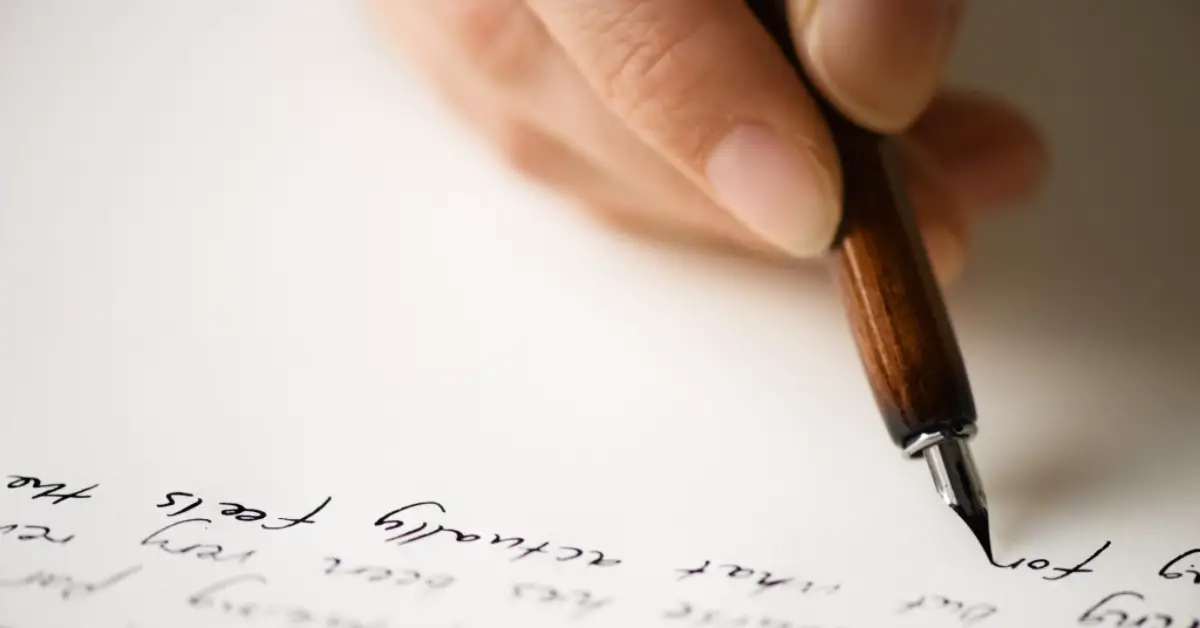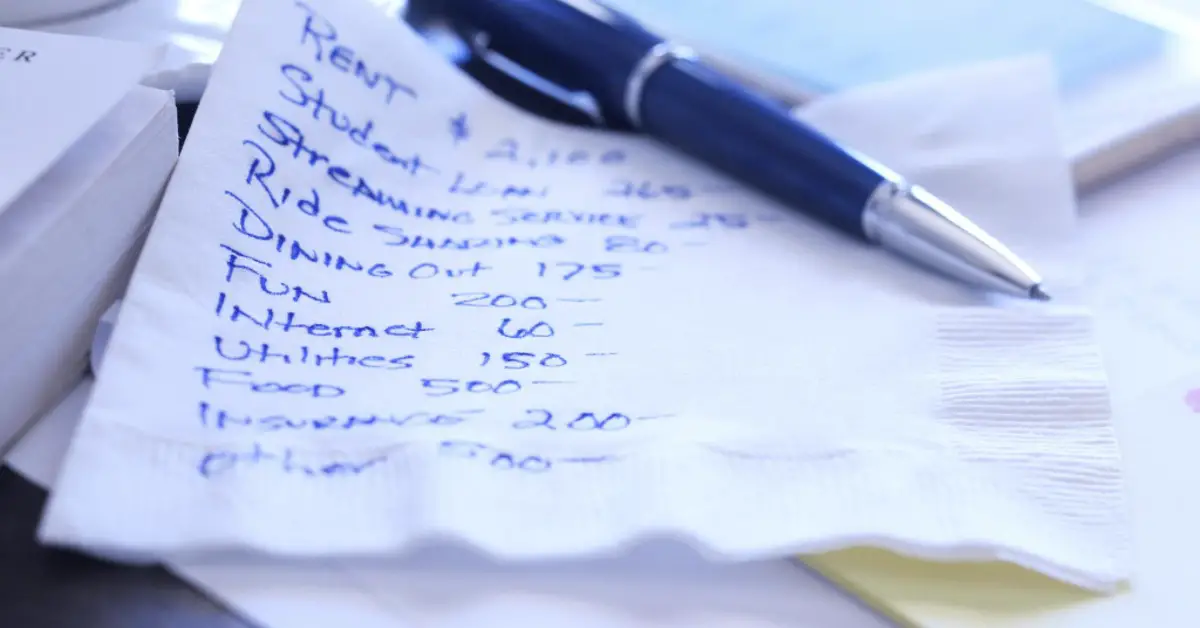Poetic Devices
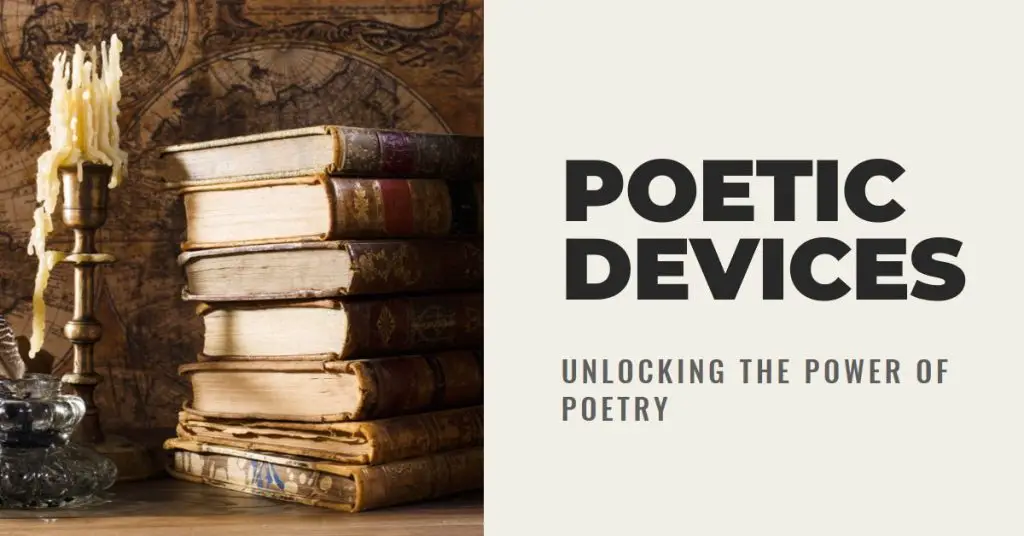
Poetic Devices communicate emotions, ideas, and experiences through carefully chosen words and phrases.
Poetry relies heavily on poetic devices to create rhythm, convey meaning, and evoke feelings in readers.
This article will explore four essential poetic devices crucial for crafting masterful poetry.
These devices include sound devices, imagery devices, and rhyme schemes and forms – each serving a specific purpose in creating a compelling piece of poetry.
By understanding these techniques and incorporating them into your writing, you can elevate your poetry to new heights and captivate your audience with the power of your words.
- Poetic Devices
- Definition of Poetic Devices
- Types of Poetic Devices
- 1. Sound Devices
- 2. Imagery Devices
- 3. Rhyme Schemes and Forms
- Examples of Poetic Devices in Literature
- Poems with Alliteration:
- Poems with Metaphors:
- Poems with Rhymes:
- How to Use Poetic Devices in Writing Poetry?
- Tips for Using Poetry Devices Effectively
- The Power of Poetic Devices
- Final Thought: Poetic Devices Inspire Creativity
- References:
Definition of Poetic Devices
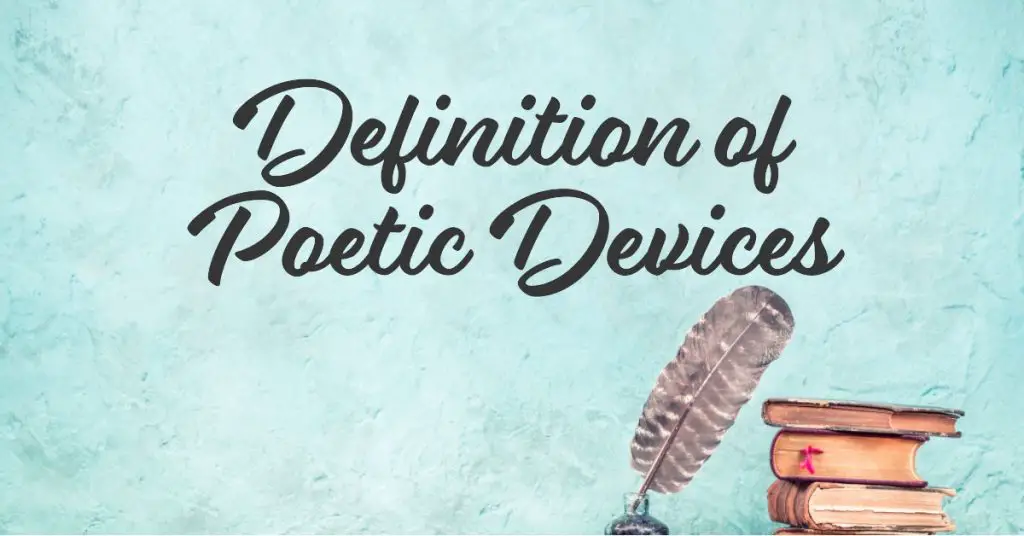
Poetic devices are literary techniques poets use to enhance the meaning, sound, and rhythm of their poems.
These devices can be found in all forms of poetry, from classic sonnets to free verse.
Some of the most common poetic devices include sound devices, imagery devices, rhyme schemes and forms, and figurative language such as metaphors.
By using poetic devices, poets can create a powerful emotional response in the reader or listener. They can also make their work more memorable and appealing to audiences.
Importance of Poetic Devices in Literature
Using poetic devices is crucial in creating a literary work that stands out from others. Without these techniques, poetry would be bland and lacklustre.
Properly using these tools can enhance a poem’s overall impact and effectiveness.
Using poetic devices also helps readers analyze poetry more effectively by allowing them to identify important aspects such as theme or tone more accurately.
By understanding these techniques deeply, readers can better appreciate poetry’s depth.
Types of Poetic Devices
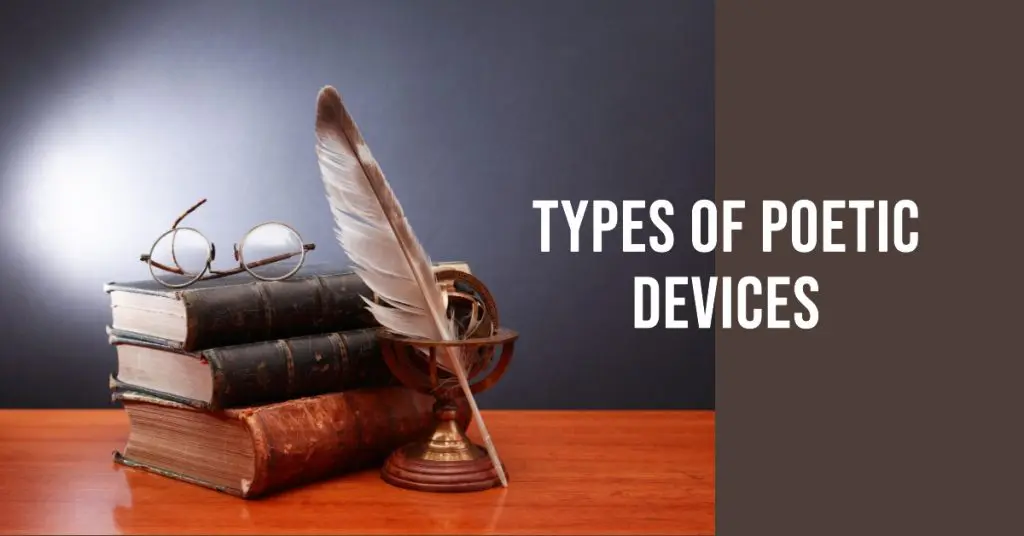
Poetry is a powerful form of art that uses language to convey emotions, ideas, and experiences.
To achieve this, poets use a wide range of poetic devices that help them to create vivid images and evoke strong emotions in their readers.
Here are some of the most commonly used poetic devices:
1. Sound Devices
Sound devices refer to the use of different sounds and rhythms in poetry. They can create a musical effect or emphasize certain words or ideas in a poem.
- Alliteration is the repetition of consonant sounds at the beginning of words in a phrase or sentence. For example, “Peter Piper picked a peck of pickled peppers” is an example of Alliteration.
- Assonance refers to the repetition of vowel sounds within words in close proximity. For example, “fleet feet sweep by sleeping geese” is an example of assonance.
- Consonance is similar to Alliteration but involves repeating consonant sounds at any point within words rather than just at the beginning. An example would be “pitter-patter,” which repeats the/ and /r/ sounds.
- Onomatopoeia uses words that imitate sounds they describe, such as “buzz,” “splash,” or “pop.”
2. Imagery Devices
Imagery devices create vivid mental pictures for readers through descriptive language. Imagery helps readers visualize what’s happening in the poem and feel connected to its content on a deeper level.
- Metaphor compares two, unlike things directly without using like or as such as “life is a journey.”
- Simile compares two things using “like” or “as.” A common example is “her eyes were as bright as the sun.”
- Personification gives human qualities to inanimate objects or animals. For example, “the wind whispered secrets through the trees.”
- Hyperbole uses strong exaggeration to make a point or create an effect, such as “I’ve told you a million times.”
- Allusion: a reference to a well-known person, place, event, or work of literature
3. Rhyme Schemes and Forms
Rhyme schemes and forms refer to the patterns of rhyme used in poems. Perfect rhyme is when two words have identical vowel sounds and final consonant sounds, such as “love” and “dove.”
- Near Rhyme: Near rhyme is when two words have similar but not identical vowel sounds. For example, “love” and “glove.”
- Internal Rhyme: Internal rhyme occurs when words inside the same line of poetry rhyme. Free Verse: Free verse is poetry without any fixed meter, pattern, or form.
Poetic devices are essential for poets to capture emotions, ideas, and experiences. By mastering these techniques, poets can create powerful works of art that resonate deeply with their readers.
Examples of Poetic Devices in Literature
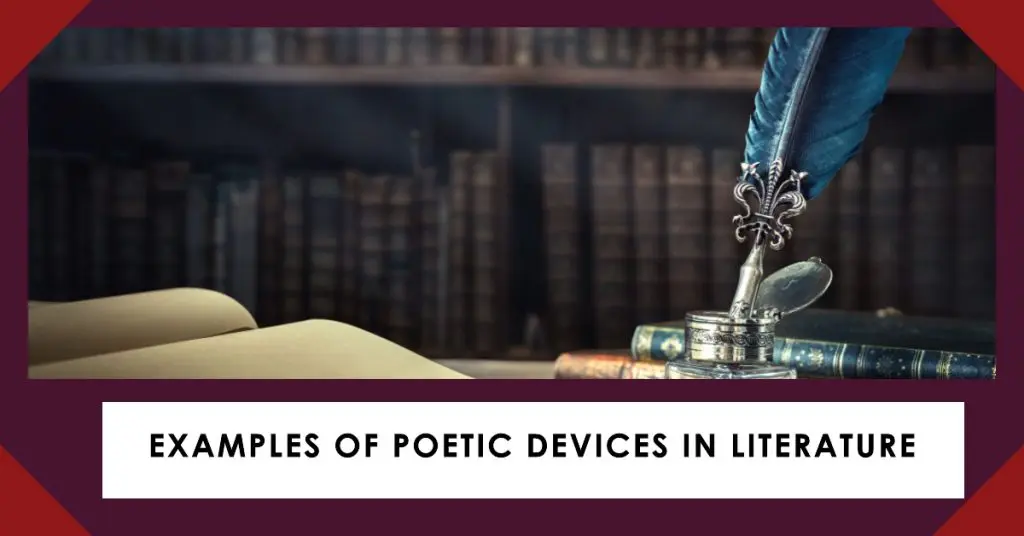
Poems with Alliteration:
“Peter Piper Picked A Peck Of Pickled Peppers.”
Alliteration is the repetition of initial sounds in a series of words. It adds rhythm and musicality to poetry.
One famous example of Alliteration comes from the tongue-twister “Peter Piper picked a peck of pickled peppers.”
This phrase showcases Alliteration and provides an excellent mnemonic to remember the sound pattern.
Repeating the “p” sound creates an enjoyable and memorable experience for readers.
Another example is Edgar Allan Poe’s poem, “The Raven,” which uses Alliteration to create a haunting atmosphere.
The first line reads, "Once upon a midnight dreary, while I pondered, weak and weary."
Poems with Metaphors:
“Life Is A Journey, Not A Destination.”
Metaphors are literary devices that create comparisons between two things that are not usually associated with one another but have some similarities.
They provide depth to poetry by adding complexity and nuance to what might otherwise be straightforward language.
One famous metaphor comes from Ralph Waldo Emerson’s essay on self-reliance, where he writes about society being like a wave.
Another example comes from Robert Frost’s poem “The Road Not Taken,” where he compares life choices to different paths in the woods:
"Two roads diverged in a wood, and I took the one less traveled by."
This metaphor suggests that making choices can be difficult because there may be unknown consequences that result from our decisions.
Poems with Rhymes:
“Roses Are Red, Violets Are Blue.”
Rhyme is the repetition of sounds that usually occur at the end of words. It creates a specific cadence in poetry and can be used to emphasize certain words or lines.
Perhaps the most well-known example of rhyme comes from the childhood nursery rhyme “Roses are red, violets are blue.”
This poem uses a simple ABCB rhyme scheme and has been adapted into many variations. Another example of rhyme comes from William Shakespeare’s sonnets.
He often employed an ABAB CDCD EFEF GG rhyming scheme, creating a sense of balance and harmony in his poetry.
For instance, in Sonnet 18, he writes:
"Shall I compare thee to a summer's day? Thou art more lovely and more temperate."
The rhyme adds musicality to these lines and helps create an overall sense of beauty within the poem.
How to Use Poetic Devices in Writing Poetry?
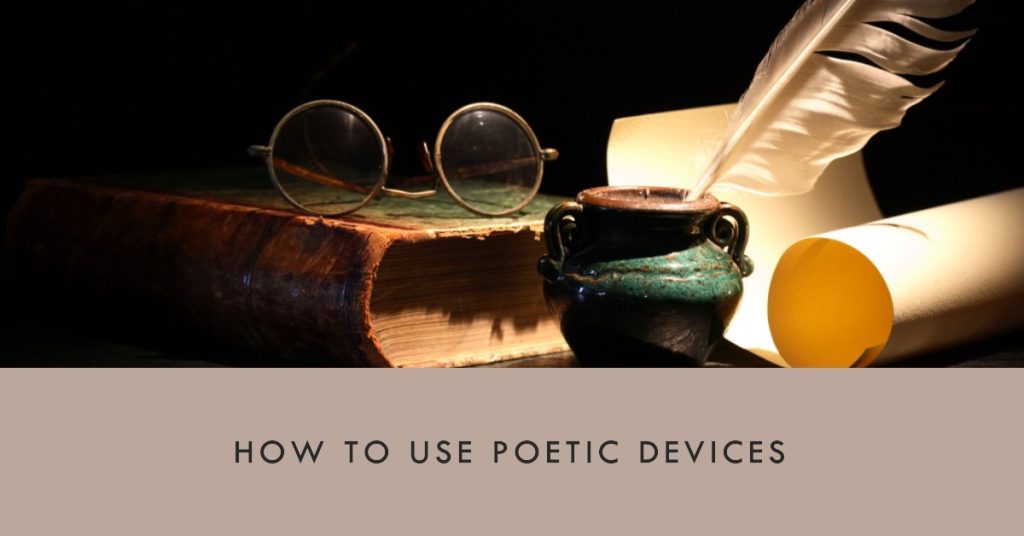
Using poetic devices not only enhances the beauty of a poem but also helps the poet convey their message effectively.
However, it’s essential to understand that not all poetic devices may fit every poem. It’s vital to use a device that compliments your message and style.
Choosing the Right Device for Your Message: Before choosing a device, writers must understand what they want their poem to convey. For instance, if you’re writing about love, metaphors, and similes can help you compare your feelings with things from everyday life.
If you’re composing an upbeat poem, using Alliteration can give it rhythm and make it more engaging. Practising the Art of Writing Poetry: Writing poetry is an art that requires a lot of practice and patience.
To get better at writing poems using poetic devices, one must consistently read poems written by others and try to imitate them. Understanding how poets use various devices can help one develop their unique style.
Tips for Using Poetry Devices Effectively
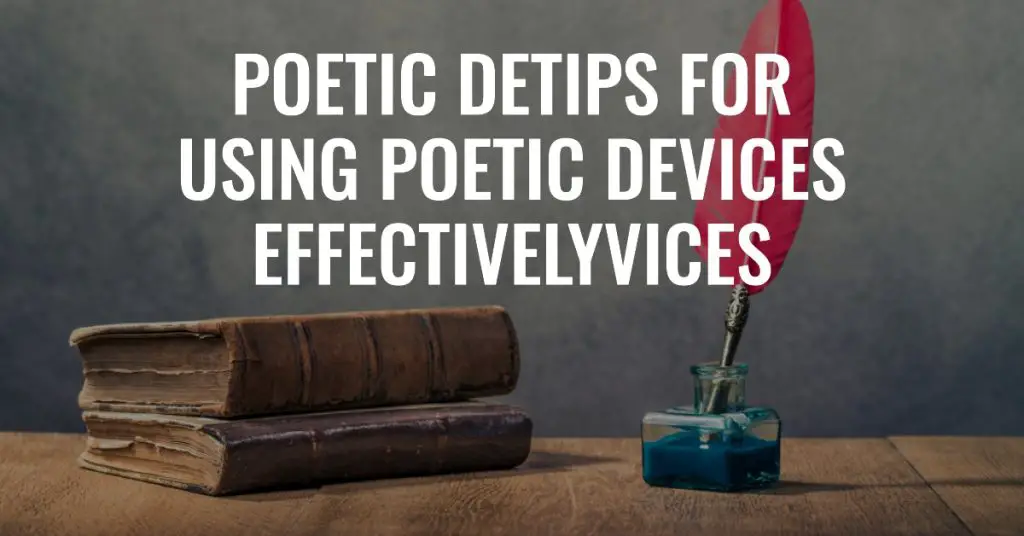
Using poetic devices effectively can turn an ordinary poem into a masterpiece. Here are some tips on how to use poetic devices effectively:
- Vary Your Use of Devices: Using too many similar-sounding or imaginative words can overwhelm readers or make them disinterested in your work. Varying the kinds of literary tools used throughout the composition makes it more engaging.
- Avoid Overusing Devices: While using literary elements often improves most poetry writings, overdoing them becomes problematic as they lose meaning or impact on readers.
- Mastering Poetic Devices: this is key to creating outstanding pieces of literature and expressing creative ideas imaginatively through written works such as poems or songs composed using metaphorical language and other figure-of-speech elements which play vital roles in giving written works depth, beauty, and meaning.
The Power of Poetic Devices
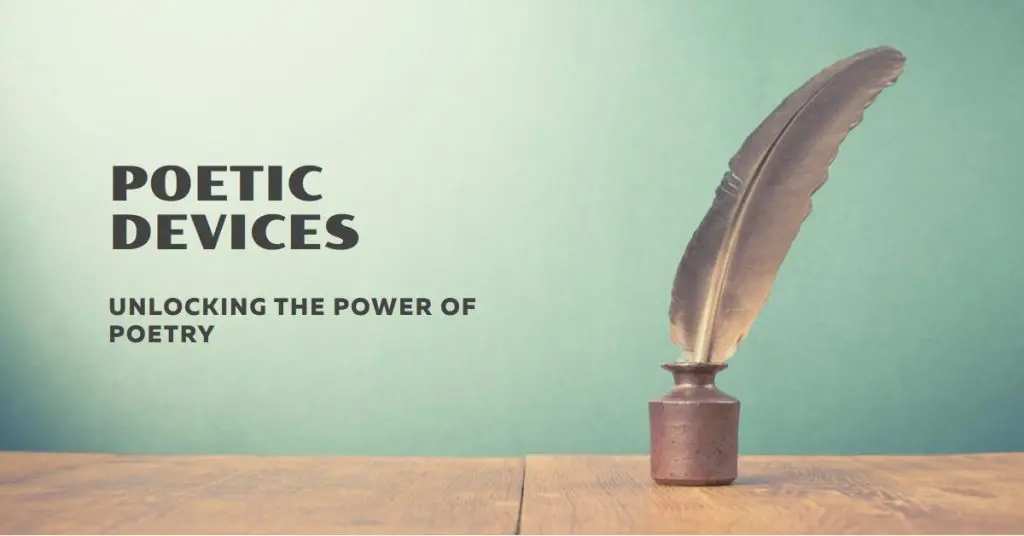
Throughout history, poets and writers have used poetic devices to create unique and moving works of literature.
These tools have been essential for writers seeking to express themselves effectively, from the use of metaphors to convey complex emotions to the use of Alliteration to create musicality in a piece.
Using poetic devices, writers can add deeper meaning and emotional heft to their work. Poetic devices are not limited to poetry alone but can be found in all forms of literature.
The most memorable lines from famous novels or speeches often utilize one or more poetic devices.
The judicious use of these tools can help writers engage with their readers emotionally while also making their writing more memorable.
Final Thought: Poetic Devices Inspire Creativity
Poetic devices inspire creativity by offering endless possibilities for expression. They open new avenues for exploring ideas and emotions while challenging writers to experiment with language and structure.
Through this experimentation, writers can push themselves beyond their limits, finding new ways to communicate complex ideas clearly and powerfully.
We see no denying the importance of poetic devices in literature; they offer endless opportunities for creativity while helping authors express themselves in more meaningful ways.
So whether you’re a poet looking for ways to make your pieces sing or a writer hoping to add depth and emotionality to your prose, poetic devices are an essential tool you cannot overlook or ignore!
References:
- Brinks, Melissa. “The 20 Poetic Devices You Must Know.” The 20 Poetic Devices You Must Know, blog.prepscholar.com/poetic-devices-poetry-terms.
- https://study.com/academy/lesson/poetic-devices-definition-types-examples.html. study.com/academy/lesson/poetic-devices-definition-types-examples.html.
- Glatch, Sean. “12 Literary Devices in Poetry: Identifying Poetic Devices | Writers.com.” Writers.com, 13 Oct. 2020, writers.com/literary-devices-in-poetry.
- “Poetic Devices.” Leverage Edu, 21 Nov. 2022, leverageedu.com/blog/poetic-devices.
- “The 27 Poetic Devices You Need to Know.” Poetic Devices: Complete Guide and Examples, 27 Apr. 2022, prowritingaid.com/poetic-devices.
- “StudySmarter US.” StudySmarter US, www.studysmarter.us/explanations/english-literature/literary-devices/poetic-devices.
